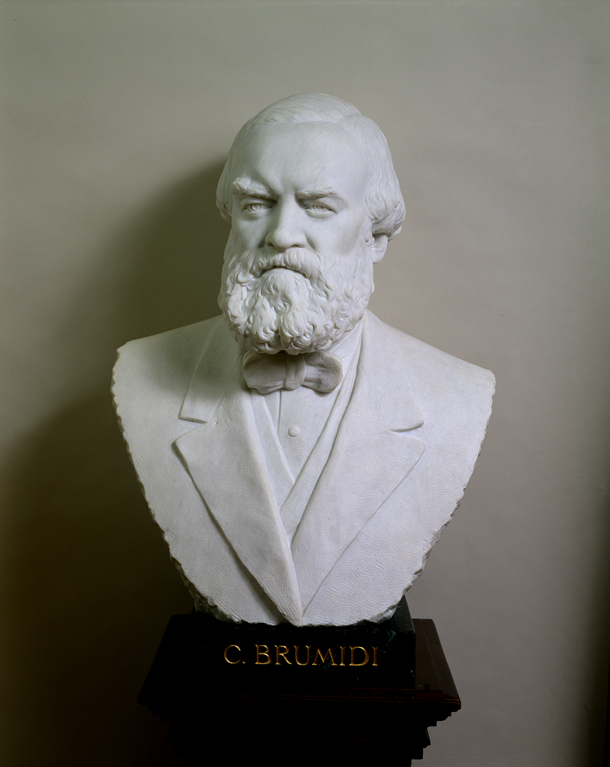
| Title | Constantino Brumidi |
| Artist/Maker | JIMILU mason ( 1930 - 2019 ) |
| Date | 1967 |
| Medium | Marble |
| Dimensions | h. 29.63 x w. 32.38 x d. 23.75 in. (h. 75.2 x w. 82.2 x d. 60.3 cm) |
| Credit Line | U.S. Senate Collection |
| Accession Number | 21.00003.000 |
In 1966 the U.S. Congress authorized the creation of a portrait bust honoring Constantino Brumidi that would be displayed in the Brumidi Corridors. The legislation was spurred in part by renewed appreciation of Brumidi following publication of a biography on him written by Myrtle Cheney Murdock, the wife of an Arizona congressman. Sculptor JIMILU mason was awarded the commission in early 1967; she based her likeness of Brumidi on photographs taken during his life. The Joint Committee approved the plaster model, and the image was translated into Carrara marble in Pietrasanta, Italy. JIMILU’s bust of Brumidi was unveiled in the Capitol Rotunda in 1968 at dedication ceremonies attended by congressional leaders and the ambassadors of Italy and Greece.
JIMILU, of Alexandria, Virginia, is known for her portrait and figurative sculptures. Her mother, Rose d’Amore Mason, was of Italian heritage, a legacy that spurred JIMILU’s interest in obtaining the Brumidi commission. Her father was former Federal Trade Commissioner Lowell B. Mason. JIMILU mason’s other works include busts of Chief Justice Frederick M. Vinson in the U.S. Supreme Court building; Speaker Samuel Rayburn at the Smithsonian Institution’s National Portrait Gallery; John F. Kennedy at the North Carolina Museum of Art; and several busts of Lyndon B. Johnson, including one in the Senate’s Vice Presidential Bust Collection. Her bronze sculpture of the groundhog Punxsutawney Phil occupies a place of honor in the town square of Punxsutawney, Pennsylvania.
The frescoes and murals of Constantino Brumidi (1805-1880) can be found throughout the U.S. Capitol. His most accessible and brilliant creations include the allegorical fresco The Apotheosis of Washington in the canopy of the Rotunda and the extensive frescoes and murals in the Brumidi Corridors. These hallways on the first floor of the Senate wing are some of the most ornate and creatively decorated public spaces in the nation. Inspired by Raphael's loggia in the Vatican, Brumidi's work in the corridors is unique in integrating classical imagery with patriotic American themes.
Born in Rome of Italian and Greek parentage, Brumidi trained in drawing, painting, and sculpture at Rome's prestigious Accademia di San Luca. By 1840, his artistic skills were put to good use when Brumidi and several other artists were commissioned to restore the historic Renaissance frescoes in the Vatican Palace. Brumidi also earned important commissions to decorate several churches and palaces in Rome. Following a pardon by Pope Pius IX for his role in Italy's republican revolution, Brumidi immigrated to the United States in 1852. Five years later he became a naturalized citizen.
In 1855, Brumidi was hired to decorate the Capitol extension with murals and frescoes. His Capitol frescoes were probably the first true frescoes to be painted in this country. Brumidi continued to embellish the walls of the Capitol for the next 25 years.
Brumidi's final years were spent painting the historic scenes in the Rotunda frieze. Proud of his achievements in America, the artist is reported to have remarked: "My one ambition and my daily prayer is that I may live long enough to make beautiful the Capitol of the one country on earth in which there is liberty." [1] He died on February 19, 1880.
1. Barbara A. Wolanin, comp., Constantino Brumidi: Artist of the Capitol (Washington, D.C.: Government Printing Office, 1998), 9.